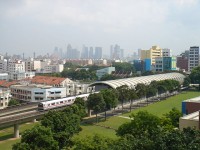Geylang is fast transforming into a favourable city fringe area, as Muneerah Bee uncovers.
From as early as 2009 or so, there have been media reports touting Geylang as the new Chinatown as Chinese nationals are choosing to live in the area, drawn by several factors such as rents and availability of food.
This seems to be further evident by the number of Traditional Chinese Medicine (TCM) clinics, supermarkets and sundry shops selling imported China-made wares and food. In addition to northern China restaurants and eateries, money changers with their loud neon signboards can be seen in Geylang. Adding to the historic and cultural essence of Geylang, Chinese clan associations are also rife there.
Property particularities
While most of the areas around Geylang Road are developed with existing properties, banks have certain tendencies when it comes to issuing home loans for properties there.
Im a recent television interview, Lewis Ng, Managing Director of PropertyGuru shared some insights on this. Banks are usually a bit more cautious and stringent on loans for properties on even-numbered lanes, specifically Lorongs four to 22 as the area is a red light district and there are only two banks which offer loans in this area, he said.
However, banks are less stringent for properties beyond Lorong 24 onwards, but loans are generally approved on a case by case basis. “On the odd side of Lorong 23 onwards, you see that banks are a lot less apprehensive. In fact, they are very favourable of loans there given the fact they are much more residential in nature,” Ng added. This includes Lorong 40 and 42.
While this has been a market practice even before the Total Debt Servicing Ratio (TDSR) was implemented, market watchers observed most banks are beginning to relax on this due to increased demand and the cleaning up of the Geylang’s image in recent years.
This, however, does not seem to deter homebuyers and investors. A report by Square Foot Research, an independent property research firm, recently revealed Geylang produced the highest median rental yield in the third quarter of 2014 at 4.74 percent.
Slew of new homes
Geylang also continues to attract developers, and the area will see several new residential developments in the coming years. TRE Residences (pictured, below), for example is a nature-inspired condominium located at Geylang East Avenue 1. The project, jointly developed by MCC Land, Greatview Development and Sustained Land, offers 250 units ranging from one to three-bedroom, four-bedroom dual key units, as well as dual key penthouses.
Not too far away, Sims Urban Oasis by a subsidiary of GuocoLand will offer 1,024 units after it received the greenlight for construction from the Urban Redevelopment Authority (URA) in Q3 2014.
Other upcoming projects in Geylang slated to be ready in the next couple of years include #1 Suites (One Suites), Ness, Guillemard Edge, Sims Edge, Rezi 3 Two, Primedge @ Geylang, and Cassia Edge.
City-fringe appeal
Among the appeal of Geylang is its close proximity to the city, high density of amenities as well as its vibrancy.
Drivers are only a few minutes away from the central business district (CBD), especially with the improved Nicoll Highway and the new Marina Coastal Expressway (MCE).
Geylang is also accessible via Aljunied MRT station on the North-South Line, and Paya Lebar MRT station which runs on the East West Line and the Circle Line.
Right across Aljunied MRT station are Geylang Methodist Primary and Secondary Schools, a convenient option for families with children. For higher education, the James Cook University (JCU) Singapore will soon be relocated to Sims Drive taking over the former site of Manjusri Secondary School.
The URA Master Plan 2014 indicates a nursing home at Geylang East Central will be built in future to meet the needs of the elderly.
A part of Geylang is also known a cultural district for the Malay community in Singapore. The Geylang Serai area hosts bustling bazaars during festive seasons. A new civic centre, Wisma Geylang Serai, will be developed within the Geylang Serai precinct by 2017, and it will house the Malay Heritage Gallery, and other cultural and arts-related facilities. The new centre is built at the former Malay Village site along Geylang Road.
That is not the only facility in Geylang which has been given a new lease of life. In fact, the Geylang River underwent a transformation which took two years under a Public Utilities Board (PUB) programme. Among the enhancements made, the canalised river was deepened and widened to increase its capacity and prevent floods.
Known as one of Singapore’s oldest rivers, it is expected to benefit from further improvements, according to the URA Master Plan 2014 a new park connector will be built between the Paya Lebar and Eunos MRT stations, with future extension towards Geylang River.
Impacting surroundings
Branching out a little outside Geylang, the surrounding Mounbatten and Guillemard area is also growing in vibrancy due to an increase in the expatriate population. Several F&B establishments have mushroomed around the area such as Maple & Market at Cassia Crescent, Brawn & Brains, and The Tuckshop along Guillemard Road.
Geylang’s close proximity to the new Singapore Sports Hub also provides more lifestyle, retail and entertainment options to residents. The Kallang Wave for example, is the retail heart of Singapore Sports Hub and it is the first mall in the country to offer sporting, lifestyle and entertainment activities under one roof.
Another new mall is OneKM by UOL near Paya Lebar MRT station which will have around 170 to 200 shops. The three-storey mall is cited by the media as an “edutainment” mall as it will house “niche enrichment schools and trades related to education”.
With all the upcoming developments and improvements, Geylang seems to be ready to rise above its reputation and welcome more residents.
Image source: Mailer diablo; Wikimedia Commons




